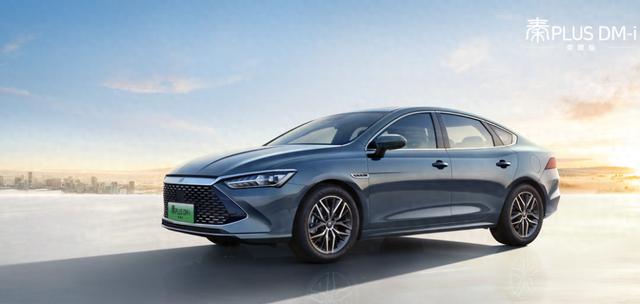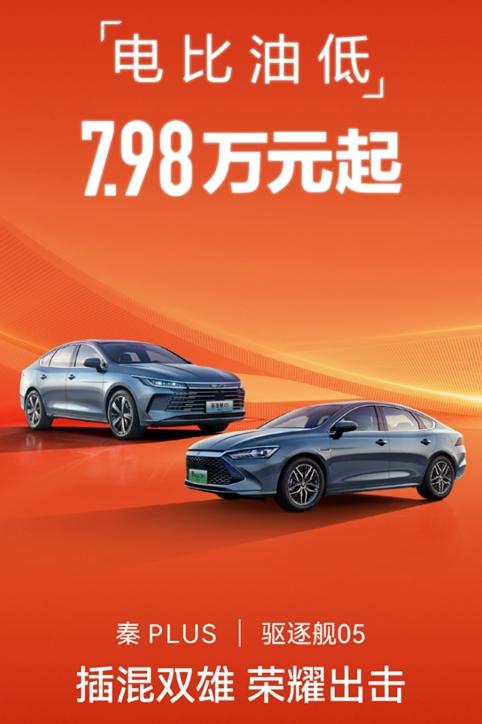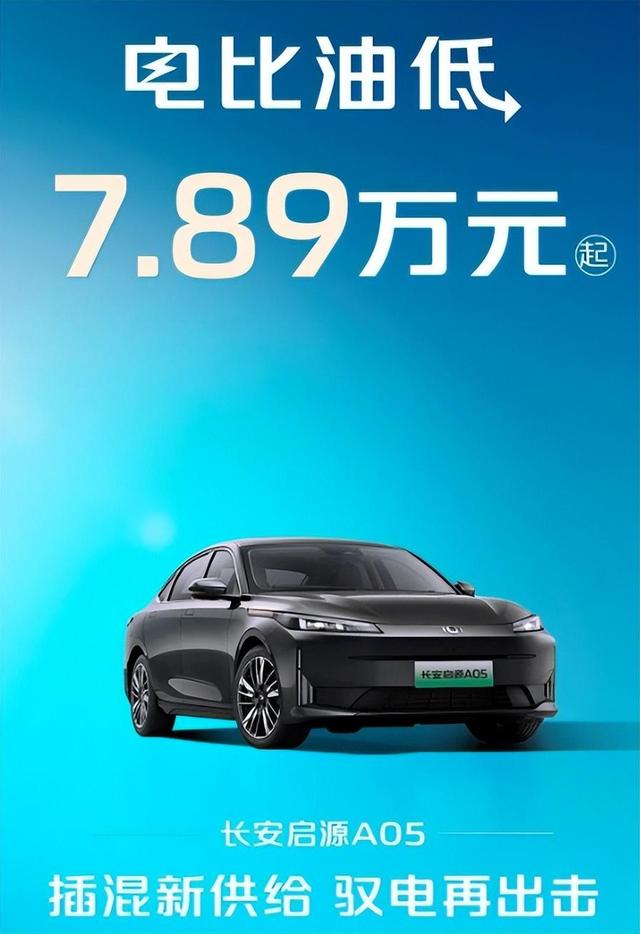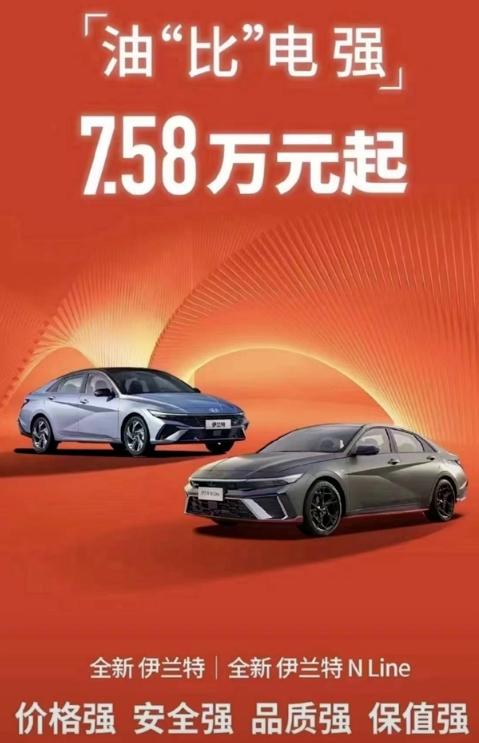The tram keeps going down, is the oil truck panicking?
China’s new energy vehicles, which enjoy an absolute price advantage in the global market, are becoming cheaper.
Just after the Spring Festival in 2024, BYD further evolved the trend of "the same price of oil and electricity" into "low fuel ratio". On February 19, the starting price of BYD’s Qin PLUS DM-i Honor Edition and Destroyer 05 DM-i Honor Edition was reduced to 79,800 yuan and 71,900 yuan respectively. This is the first time that the price of domestic new energy vehicle hybrid models has dropped to the 70,000 yuan range, which is even lower than the guide price of many fuel vehicles of the same level.

On the same day, Wuling, Changan Automobile, Nezha Automobile, Beijing Hyundai and other car companies have successively released price reduction news of a number of models, most of which are within the 100,000 yuan level. The price war that has continued since the beginning of 2023 shows no signs of weakening.
Due to cost, technology and other reasons, the price of new energy models was generally higher than that of fuel models of the same level, which caused consumers to complain: "50,000 buy more new energy can only buy’old man music ‘, but buy fuel cars can buy authentic A-class cars". Now, the price of electric vehicles is not only starting to be on par with fuel vehicles of the same level, but even lower. At the same time, the survival space of joint venture fuel vehicles is further squeezed.
"It will be a regular trend to develop from’the same price of oil and electricity ‘to’low ratio of electricity to oil’." At the China Electric Vehicle 100 Achievement Conference and the 100 People’s Association (2024) Expert Media Exchange Conference held on February 27, Ouyang Minggao, an academician of the Chinese Academy of Sciences and vice chairperson of the China Electric Vehicle 100 People’s Association, predicted that "The market share of the A-class car market will increase significantly this year."
The price has been reduced again.
In 2023, BYD, which was firmly in the top position in domestic passenger car sales, launched the first round of price war after the Spring Festival in 2024.

BYD’s model is very popular in the market in 2023. Data show that BYD Qin PLUS ranks third in the domestic compact car sales list in 2023, with sales reaching 307,400 units, second only to Xuanyi and Langyi. Now, the official price reduction of Qin PLUS DM-i Honor Edition has also complicated the competition situation of joint venture compact fuel vehicles.
Data show that BYD Qin PLUS DM-i Honor Edition sold 23,000 vehicles in the first week of price reduction. Ouyang Minggao predicted that the "new energy vehicle market pattern will develop from pure electricity to pure electricity and plug-in/range extension."
BYD’s price cut caused a chain reaction in the market.
On the same day, Zhou Jinkai, deputy general manager of SAIC-GM Wuling brand business department, said in Weibo, "One word, follow!" Immediately, the price of Wuling Starlight 150km advanced version of the model dropped from the previous 105,800 yuan to 99,800. It is understood that Wuling Starlight was listed in December 2023, and the new car launched CLTC comprehensive cruising range 150km and 70km versions, priced at 105,800 yuan and 88,800 yuan respectively. After BYD reduced the price, the price of Wuling Starlight 150km version was reduced by 6000 yuan, making the price of the whole series within 100,000 yuan.
Nezha Automobile announced a number of main models to reduce prices, including Nezha X all-series price reduction of 22,000 yuan, Nezha AYA all-series price reduction of 8,000 yuan, Nezha S all-series price reduction of 5,000 yuan. At the same time, Nezha Automobile launched a value-preserving exchange policy. From now until March 31, 2024, the purchase of Nezha S and Nezha GT models can enjoy the right to buy Nezha Automobile all-series new cars at a 30% discount within 2 years.

Changan Qiyuan also issued the slogan of "low electricity than oil", announcing that its two models, Changan Qiyuan Q05 and Changan Qiyuan A05, followed up with price cuts. The starting price of Qiyuan A05 was reduced from 89,900 yuan to 78,900 yuan, and the cash discount was as high as 11,000 yuan; Q05 was reduced to 73,900 yuan.
More than that, on February 20, Geely Emgrand L HiP Longteng version was listed, launching 100 kilometers beyond the type, 100 kilometers excellent type, the official guide price was 89,800 yuan, 99,800 yuan. Combined with the previous price, the price of the entry model was reduced by 20,000 yuan, and the price of the high-end model was reduced by 23,000 yuan.

In response to BYD’s price adjustment of "electricity is lower than oil", Beijing Hyundai shouted the slogan "oil is stronger than electricity" in response, and the official announcement followed up with the price reduction. The starting price of the new Elantra has dropped to the range of 70,000 yuan, which is 75,800 yuan. As a compact car owned by Beijing Hyundai, the Elantra will sell 109,000 cars in 2023 and is also the best-selling model. Competitors include Xuanyi, Langyi and Corolla.
The family compact A-class car has always been the main sales area of fuel vehicles, and it is also a "battleground" for automobile companies, and has an important position in the automobile sales market. "Most of the models that have been reduced in price are concentrated in the A-class sedan field," said Cui Dongshu, secretary-general of the National Passenger Car Market Information Association. "Car companies usually reduce the price of A-class cars to gain market share, and B-class cars and C-class cars to gain profits. The profits obtained by mid-to-high-end B-class cars and C-class cars can fully cover the loss of A-class cars. In the future, the price reduction of mid-to-high-end automobile products will not exceed that of A-class cars."
"With the rapid increase in the penetration rate of new energy vehicles, the scale of the traditional fuel vehicle market has gradually shrunk, and the contradiction between the huge traditional production capacity and the gradually shrinking fuel vehicle market has brought more intense price wars." Cui Dongshu believes that the fundamental reason for the recent price war in the passenger car market is the replacement of old technologies by new technologies and the substitution process of new energy vehicles for fuel vehicles. In the process of establishing a new market order, the competition between new and old manufacturers is intense. It is expected that this process will last for several years until a new pattern is formed.
At the same time, many new energy models can achieve price reduction, which has a certain relationship with the continuous decline in their costs. For example, the current price of battery-grade lithium carbonate has dropped from the highest of 600,000 yuan per ton to less than 100,000 yuan per ton. According to data released by Shanghai Steel Union, the average price of battery-grade lithium carbonate was quoted at 97,000 yuan/ton on February 26.
Zhang Yongwei, vice-chairperson and secretary-general of the China Electric Vehicle 100 Association, said that factors such as technological iteration, process improvement, scale increase and stable raw material prices will drive down the cost of global power batteries. Zhang Yongwei said that the cost of lithium batteries is expected to drop by another 25% in 2030, further promoting "the same price of oil and electricity".
When is it profitable?
After another round of price wars, the price advantage of China’s new energy vehicles has become increasingly apparent.
Market research agency JATO Dynamics previously released a survey report shows that the average price of electric vehicles in Europe is 66,800 euros (about 520,000 yuan), and the average price of electric vehicles in the United States is 71,000 dollars (about 524,000 yuan). The average price of electric vehicles in China is the lowest, only 32,800 dollars (about 240,000 yuan). That is to say, the average price of electric vehicles in China is only about half of the price of electric vehicles in the United States or Europe.
The survey also pointed out that in addition to being inexpensive, Chinese electric vehicles also have excellent performance. Compared with European and American electric vehicles at the same price, Chinese electric vehicles have a stronger competitive advantage in terms of performance and configuration.
MIIT data show that in 2023, our country’s automobile production and sales reached 30.161 million and 30.094 million vehicles respectively, an increase of 11.6% and 12% year-on-year, a record high, ranking first in the world for 15 consecutive years. Among them, the performance of new energy vehicles is particularly outstanding. According to the data of the National Passenger Car Market Information Joint Conference, the wholesale volume of new energy passenger vehicles in 2023 reached 8.864 million, an increase of 36.3% year-on-year; the wholesale penetration rate of the whole year was 34.7%, an increase of 6.6 percentage points year-on-year.
Ouyang Minggao anticipates that the market share of new energy vehicles is expected to increase by 5-10 percentage points this year, reaching 36% -41%. Optimistically, it is expected to break through 40%. It will approach 50% in 2025 and exceed 50% in 2026. Occupy the dominant position in the automotive market. Wang Chuanfu, chairperson and president of BYD, also said recently that it is expected that the penetration rate of new energy vehicles will exceed 50% this year.
However, behind this beautiful report card, how to improve profitability is still a problem faced by most car companies. "Most new energy automobile companies, especially those that are mainly domestic sales, have not yet achieved profitability." At a press conference held by the State Council Information Office recently, Xin Guobin, deputy director of MIIT, pointed out a series of problems existing in the current automobile industry, and the difficulty of corporate profitability is one of the key points he talked about. Yang Xueliang, a senior executive of Geely Automobile, said bluntly: "We can’t just focus on the penetration rate. If the development of new energy vehicles is only at a loss, the development of most enterprises is not sustainable, and it is not a good phenomenon. We still need to demand the market for high value and good experience!"
"The new energy automobile industry has a market of 9 million vehicles. Overall, the entire industry is still suffering serious losses. Now there are about 100 Chinese and foreign passenger car brands, and only four or five brands are profitable. I believe that in two years at most, this pattern will change." Zhu Huarong, chairperson of Changan Automobile, said frankly at the 2024 Changan Automobile Global Partner Conference that in the entire industrial chain, Changan New Energy is losing money, and it is losing a lot. Basically everyone is the same.
The report of Huachuang Securities Research Report pointed out that the price pressure of the automobile industry in 2024 is still relatively large, and a "price war" that will be recorded in the history of China’s automobile market may be born. In the context of the fact that most car companies have not yet achieved profitability, the advancement of the price war seems to have some tragic colors.
"The overall profitability of China’s new energy vehicles does need to improve." Ouyang Minggao said that due to the early layout of fuel vehicle technology, it is now in the stage of centralized monetization, while new energy vehicles are still in the investment period, which is a necessary stage for new things to go through. "It takes time to turn from ugly duckling to white swan, but now BYD and Ideal are both profitable?" In Ouyang Minggao’s view, it will be sooner or later for new energy vehicle companies to achieve profitability.